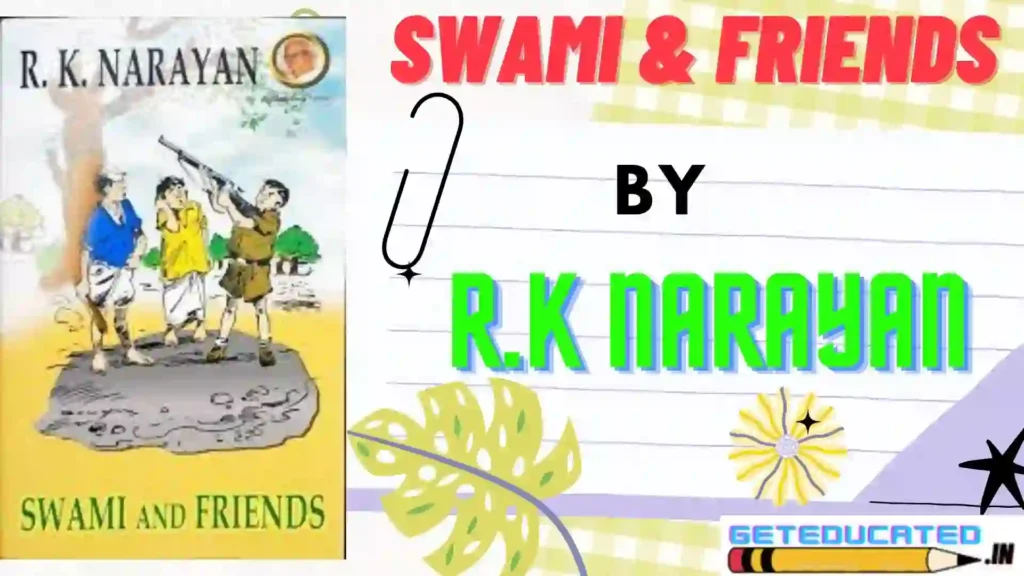
Swami and Friends is an Indian book written in English published in 1935. The work was the first novel ever published by the famous Indian author R. K. Narayan. The novel is the first of a trilogy of novels. The second is entitled The Bachelor of Arts and the third The English Teacher. The trilogy, which counts among his earlier fiction, focuses largely on problematic social practices, such as the institution of schooling and culture of punishment. The novel Swami and Friends is an episodic narrative that follows the daily life of Swaminathan, a charismatic and lazy schoolboy, in the fictional South Indian town of Malgudi with his father, mother, and granny. He attends the Albert Mission School and has an established cadre of friends, including Samuel “the Pea,” Sankar, Somu, and Mani, but the arrival of a new boy in school, Rajam, son of the police superintendent who speaks English like a European, threatens Swami’s popular status. They become rivals, enemies even, but swiftly reconcile and become fast friends.
The chapter, entitled “Broken Panes,” announces the date: the 15th of August in 1930. In doing so, the novel pans out beyond the private life of Swami and even the provincial life of Malgudi, entering the scale of the global, connected by the calendar. The date marks a day of protest against the arrest of Gauri Sankar, a prominent political worker in Bombay. Swami listens to a speech on how Indians have been reduced to “slaves” and have forgotten their glorious civilizations that they come from-of Ramayana and Mahabharata-and how far they have fallen now under British colonial rule. He blames the disciplining of Indians to the colonial bureaucracy. Swami is deeply stirred by the speaker’s eloquence, shouting “Gandhi ki Jai,” roughly translating to “Victory for Gandhi.” For the rest of the evening, Swami thinks about the political speech and becomes politicized, resolving to boycott English goods and only wear khaddar, or Indian homespun cloth. Mani examines Swami’s own coat and declares that it is Lancashire cloth. The crowd remains riled up and bursts out in nationalistic slogans and songs. Someone accuses Swami of wearing a foreign cap, and Swami quails in shame, ultimately flinging it into the fire as an act of patriotism.
The loss of his cap poses a problem the next day, however, as he cannot go to school without a cap. As he walks to the school gate, a stranger stops him and says that there is no school today due to a famous political figure being sent to prison, which Swami enthusiastically embraces because it gives him a solution for his lack of a cap. He sees a crowd gathering around and joins in. The headmaster urges the students to return to their classes, but the boys refuse, and the headmaster withdraws in defeat to thundering cries of nationalism and freedom. Swami, feeling freed by his anonymity in the crowd, notices a protester throwing stones at the windowpanes of the school building and joins him. He throws stones at the windows of the headmaster’s room, taking deep pleasure at hearing the glass shatter.
The crowd moves from the Albert Mission to another school, the Board High School, and a spokesperson declares that the school must be closed because their leader is in the gaol, prison. The headmaster refuses, and the crowd becomes belligerent and starts smashing furniture and windows. Most of the students, including Swami, join the frenzy. The crowd is successful in shutting down the Board School and moves down the road, singing and sloganeering. The protestors are confronted by fifty policemen armed with lathis (clubs) led by, to Swami’s horror, Rajam’s father, the deputy police superintendent. He orders his men to charge at the civilian protesters, dispersing the crowd. Swami runs away and is nearly killed as he witnesses his fellow protestors being brutally beaten by the police. Caught by a policeman who asks him what business he has here, Swami pleads ignorance and is let go with a light tap.
When his father returns home from work, he speaks about the strikes and inquires if Swami was involved, which Swami denies. He makes up an excuse that a striker tore off his cap because he thought it was foreign, which his father debunks, saying that he had bought it from the khaddar stores, meaning it is home-made. Swami cannot fall asleep, his body bruised and heavy all over. He contemplates how a policeman had called him a monkey, when in fact, it was the policemen who had acted like monkeys. The next day, the headmaster enters class in a rage and coerces all the students who were absent from class yesterday to identify themselves and explain their absence. He has each of them stand up, one by one, and explain, and promptly abuses them for their flimsy excuses and issues a punishment. Swami is shaking, and when the headmaster gets to him, Swami is so distressed that he speaks in disjointed, incoherent fragments. The headmaster brings in the peon (a low-ranking worker) who says that he saw Swami throwing stones at the headmaster’s windows. Swami is without defense, and the headmaster begins beating him to the extent that Swami’s body is on fire. Suddenly, a rush of courage streams through his body and he jumps away from the headmaster, grabs his books and runs away, muttering, “I don’t care for your dirty school”. M Six week later, Rajam forgives Swami for his “political sins” and posits that C they start a cricket club, which he crowns the Malgudi Cricket Club or M.C.C. for short. Swami now attends the Board High School, which Rajam and others look down upon as an inferior institution. Swami is relatively happy at his new school as his new classmates are curious about him and give him a lot of attention. His friendship with Rajam and Mani remains intact, but his other relationships have largely dissolved.
The story, which had always been enmeshed in historical conditions, turns most explicitly toward history with the strike on August 15, 1930 as part of Gandhi’s non-cooperation movement. Swami’s irreverent disposition aligns with the rebellious, nationalist uprisings, and he gets caught up in the frenzy and ends up breaking the windows of his school building, which puts him at odds with Rajam, who is aligned with institutional power as the son of the police superintendent. Swami’s self-expulsion from the Albert Mission School is a culmination of his continuous conflict toward school and authority figures at large and represents a desperate seizure of freedom through escape, but one that ends him in yet another institution, the Board High School.
The police’s violent suppression of the strike is an explicit instance of the motif of physical violence that runs through the novel. The lathis (clubs) that the policemen use on the protestors resonate with the cane that the headmaster uses on Swami to punish him for missing class. Swami’s teachers and the policemen are united in their use of physical violence to enforce their lessons and punish the disobedient. Thus, physical violence is used by institutions as a tool of pedagogy and punishment. Violence is a frequent tool of oppression. The two times Swami runs away from school-first from Albert Mission School and then the Board High School-occur when he is being beaten.
The political action of a strike is resonant with the anti-work theme implicit in Swami’s resistance to school. School is his most recurring antagonist during the story. Swami does his homework at the very last minute in the morning before school begins and resists efforts to discipline him. His boyish rebelliousness, however, is politicized when he attends the rally and participates in the school strike. There exists a kind of parallel between the political non-cooperation independence roiling through India and Swami’s own private attempts at freeing himself from the yoke of school; something deep inside Swami is stirred when he hears the political speeches calling for Indian independence, as he himself is striving for a freedom from institutions that have defined his life.
THANK YOU FOR VISITING US!
I believe that this answer will surely help you to score full or excellent marks. Keep visiting our website for valuable contents, absolutely free, No login no Sign Up, stay hassle free and Enjoy!
